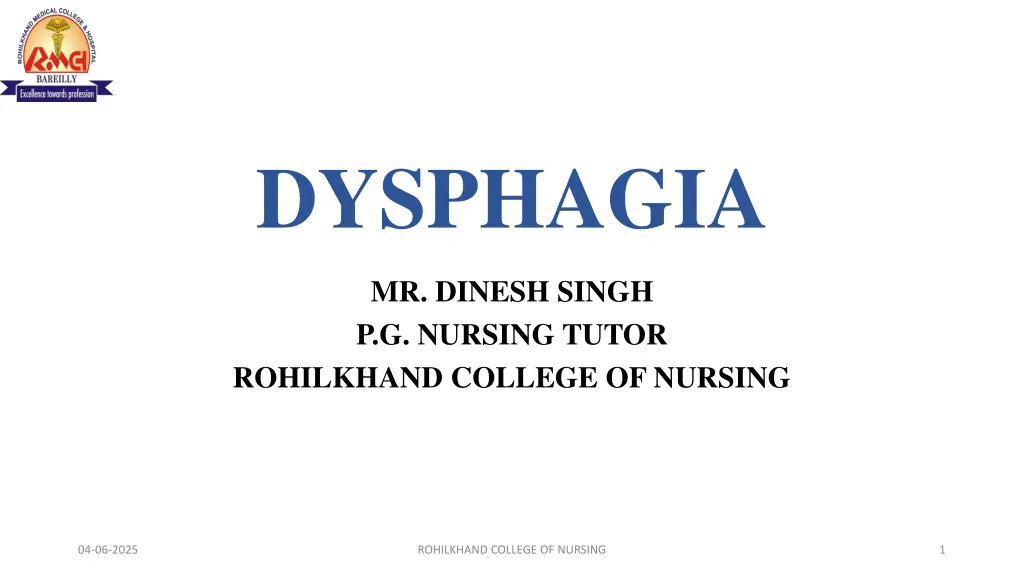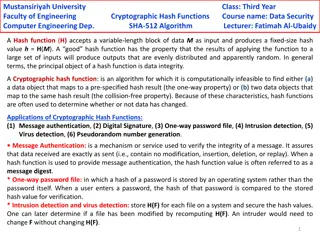
Understanding Dysphagia: Causes, Symptoms, and Management
Explore the world of dysphagia, a condition characterized by difficulty swallowing. Learn about its causes, clinical manifestations, diagnostic evaluation, and management strategies. Discover the importance of early detection and prevention of dysphagia for better patient outcomes.
Download Presentation

Please find below an Image/Link to download the presentation.
The content on the website is provided AS IS for your information and personal use only. It may not be sold, licensed, or shared on other websites without obtaining consent from the author. If you encounter any issues during the download, it is possible that the publisher has removed the file from their server.
You are allowed to download the files provided on this website for personal or commercial use, subject to the condition that they are used lawfully. All files are the property of their respective owners.
The content on the website is provided AS IS for your information and personal use only. It may not be sold, licensed, or shared on other websites without obtaining consent from the author.
E N D
Presentation Transcript
DYSPHAGIA MR. DINESH SINGH P.G. NURSING TUTOR ROHILKHAND COLLEGE OF NURSING 04-06-2025 ROHILKHAND COLLEGE OF NURSING 1
OBJECTIVES Introduction of the. Define the . Explain the causes of . State the clinical manifestations of . Elaborate the diagnostic evaluation of. Discuss the management of. Describe the prevention of. 04-06-2025 ROHILKHAND COLLEGE OF NURSING 2
INTRODUCTION The word dysphagia is derived from the Greek phagia (to eat) and dys (with difficulty). Dysphagia is difficulty swallowing, taking more time and effort to move food or liquid from your mouth to your stomach. Dysphagia can be painful. In some cases, swallowing is impossible. 04-06-2025 ROHILKHAND COLLEGE OF NURSING 3
DEFINITION Dysphagia and difficulty with swallowing can be caused by an esophageal disorder. Specific causes are include. 1. Neuromotor malfunction 2. Mechanical obstruction 3. Cardiovascular abnormalities 4. Neurological diseases 04-06-2025 ROHILKHAND COLLEGE OF NURSING 4
ETIOLOGY Esophageal dysphagia 1. Achalasia: When the lower esophageal muscle (sphincter) doesn't relax properly to let food enter the stomach. 2. Diffuse spasm: This condition causes high-pressure, poorly coordinated contractions of the esophagus, usually after swallowing. Diffuse spasm affects the involuntary muscles in the walls of the lower esophagus. 3. Esophageal stricture: A narrowed esophagus (stricture) can trap large pieces of food. 4. Esophageal tumors: Difficulty swallowing tends to get progressively worse when esophageal tumors are present due to narrowing of the esophagus. 04-06-2025 ROHILKHAND COLLEGE OF NURSING 5
CLASSIFICATION 1. OROPHARYNGEAL DYSPHAGIA Tonsilitis Peritonsillar abscess Stomatitis Tongue cancer 04-06-2025 ROHILKHAND COLLEGE OF NURSING 6
Conti 2. ESOPHAGEAL DYSPHAGIA Crohn s disease Pharyngeal spasms Aortic aneurysm Malignant neoplasm Hiatus hernia Foreign body Benign stricture Thyroid malignancy 3. FUNCTIONAL DYSPHAGIA Some patient s as having no organic cause for dysphagia that can be found 04-06-2025 ROHILKHAND COLLEGE OF NURSING 7
CLINICAL MANIFESTATION Pain in swallowing Pulmonary aspiration Difficulty controlling food in the mouth Difficulty in swallowing. Coughing, chocking Unexplained weight loss 04-06-2025 ROHILKHAND COLLEGE OF NURSING 8
DIAGNOSTIC EVALUATION History collection Physical examination Barium swallow X-ray Esophagoscopy and laryngoscopy Ultrasonography CT Scan 04-06-2025 ROHILKHAND COLLEGE OF NURSING 9
MANAGEMENT For difficulties in the mouth and throat area, treatments are generally focused on swallowing therapy, including exercises and dietary changes. Feeding tubes are also an option for treating dysphagia including nasogastric or endoscopic tubes. 04-06-2025 ROHILKHAND COLLEGE OF NURSING 10
NURSING MANAGEMENT 1. Make sure that emergency equipment: Including suction oxygen and face mask is at the bed- side. 2. Place the patient in an upright sitting position in a chair or support with pillows in high-lower's position. 3. Provide mouth care before and after meals. Suction the patient if secretion are present. If the patient's mouth is dry provide a lemon or pickle to suck on. 4. Prepare an environment that is pleasant, peaceful and without interruption. 04-06-2025 ROHILKHAND COLLEGE OF NURSING 11
CONT 5. Avoid sticky foods, e.g. peanut butter, chocolate, milk etc. 6. Mugs and glasses with a straw should be used for liquids. 7. Instruct the patient against talking during the meal 04-06-2025 ROHILKHAND COLLEGE OF NURSING 12
SUMMARY 04-06-2025 ROHILKHAND COLLEGE OF NURSING 13
REFERENCES 04-06-2025 ROHILKHAND COLLEGE OF NURSING 14
04-06-2025 ROHILKHAND COLLEGE OF NURSING 15















